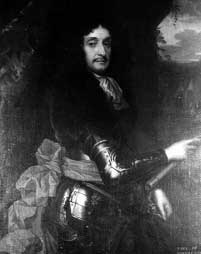Colonel John Fitzgerald The Earl of Middleton
1664-1674
The Tangiers Regiment
 He was born in 1619. Unusually for a future Earl, Middleton’s
origins were obscure and probably humble. He first appears as pikeman
in the regiment raised in 1632-3 by Sir John Hepburn for service
in France. Having presumably fought in Lorraine, he returned to
Scotland (1639) in the Covenanting army under Alexander and David
Leslie. From Colonel he rose to Lieutenant General and second in
command at Philiphaugh (1645) after which he negotiated the surrender
of Montrose. Under the Engagement he at last found himself on the
Royalist side and during the 1648 invasion of England commanded
the cavalry at the Battle of Preston.
He was born in 1619. Unusually for a future Earl, Middleton’s
origins were obscure and probably humble. He first appears as pikeman
in the regiment raised in 1632-3 by Sir John Hepburn for service
in France. Having presumably fought in Lorraine, he returned to
Scotland (1639) in the Covenanting army under Alexander and David
Leslie. From Colonel he rose to Lieutenant General and second in
command at Philiphaugh (1645) after which he negotiated the surrender
of Montrose. Under the Engagement he at last found himself on the
Royalist side and during the 1648 invasion of England commanded
the cavalry at the Battle of Preston.
After the further defeat of the Engagers at Dunbar, Middleton held out in the Highlands (1650) and it was in an attempt to join him that Charles II briefly eluded his Covenanting hosts and escaped up Glen Cloval an incident known as ‘The Start’.
Under the 1650 Resolution, Middleton received an amnesty and fought at Worcester where he was captured and sent to the Tower of London. He escaped to France and in 1653 briefly commanded a Royalist rising in the Highlands under the Earl of Glencairn as Charles II’s Commander-in-Chief. It collapsed after a skirmish at Dalnaspidal on the Drumochter Pass. He returned to court-in-exile, was created Earl (1656) and, at the Restoration, Royal Commissioner to the Scottish Parliament, ‘an appointment which incurred aristocratic jealousy’ (G.Donaldson). Middleton fanned the jealousy by falling out with John Maitland, Earl of Lauderdale, and by supporting the reimposition of episcopacy. Deprived of office in 1663, he ended his days as Governor of Tangier.
As Governor he built a large Government House overlooking the Straits and lived in Vice Regal style. Sadly he fell one night when befuddled with drink, broke his shoulder and later died from his injuries on 25th January 1675.
« Previous ![]() Back to list
Back to list ![]() Next »
Next »
